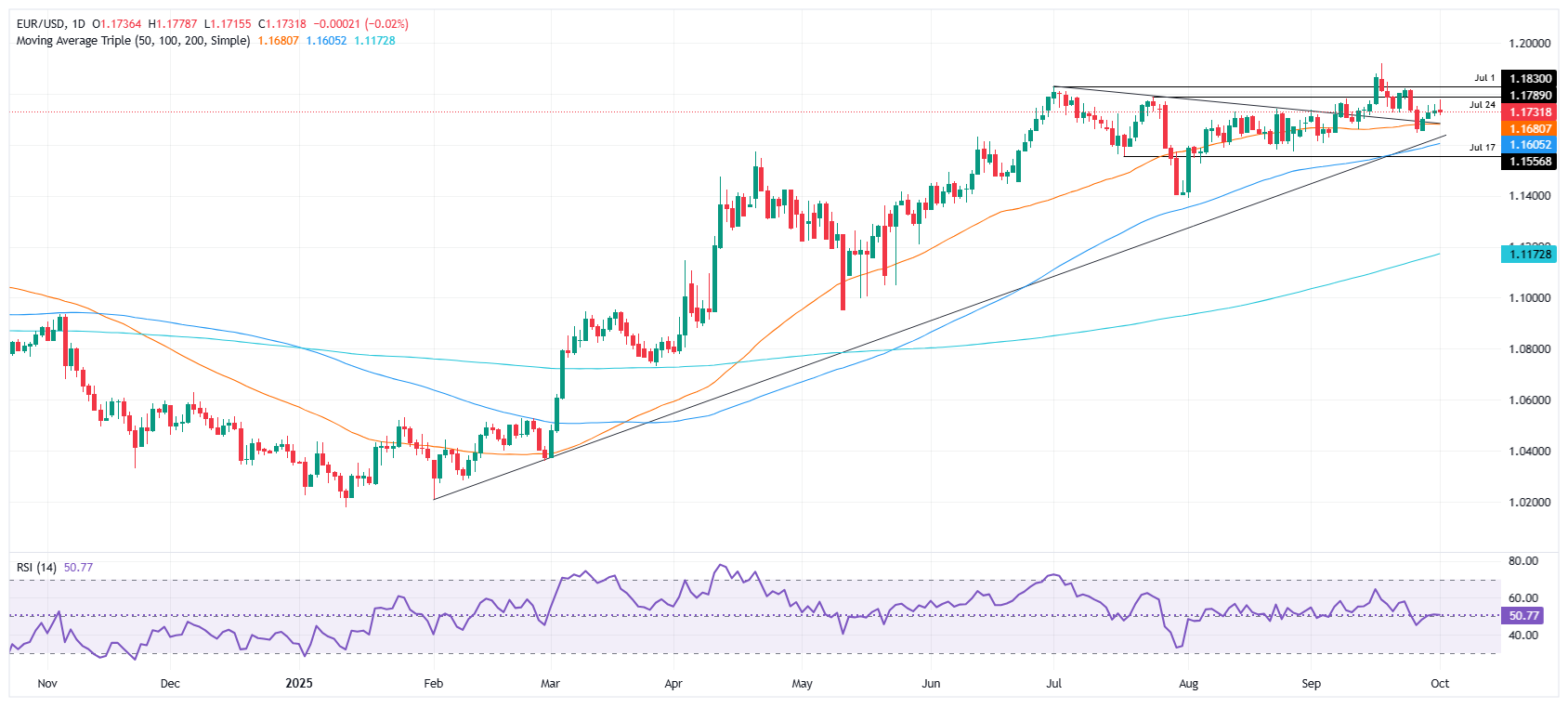Created
: 2025.10.02














![]() 2025.10.02 07:06
2025.10.02 07:06
EUR/USD is steady late during the North American session as investors digest a soft jobs report and shrugs off the shutdown of the US government. The lack of an agreement between the White House and Democrats would prolong the shutdown and delay US economic data releases. The pair trades at 1.1720 unchanged.
US ADP National Employment Change in September was dismal and highlighted the weakness of the labor market. Business activity in the manufacturing sector in the US, improved but contracted for the seventh straight month.
Regarding political turmoil in the US, Vice-President JD Bance said that he does not think the shutdown will last long, vowing to do everything possible in the coming weeks to ensure people receive essential services.
Meanwhile, Fitch Ratings said that a government shutdown does not have near-term impact on the "AA+ stable" creditworthiness of US debt. The agency revealed that the shutdown is estimated to reduce GDP growth by 0.1-0.2% per week.
In the Eurozone, the HCOB Manufacturing PMI for September exceeded estimates, while the Harmonized Index of Consumer Prices (HICP) for the bloc ticked up. Despite this, the European Central Bank (ECB) is expected to remain on hold after President Christine Lagarde said that the risks to inflation "appear quite contained in both directions."
EUR/USD has held firm above the 1.1700 level for four consecutive sessions but continues to struggle below 1.1750, keeping upside momentum in check. The Relative Strength Index (RSI) is flattening near the neutral 50 mark, signaling indecision.
If EUR/USD breaks above 1.1740, it would expose resistance at 1.1800, followed by the yearly peak at 1.1918. On the downside, a drop below 1.1700 would target 1.1650, with further support at the 100-day SMA near 1.1611.

The Euro is the currency for the 19 European Union countries that belong to the Eurozone. It is the second most heavily traded currency in the world behind the US Dollar. In 2022, it accounted for 31% of all foreign exchange transactions, with an average daily turnover of over $2.2 trillion a day. EUR/USD is the most heavily traded currency pair in the world, accounting for an estimated 30% off all transactions, followed by EUR/JPY (4%), EUR/GBP (3%) and EUR/AUD (2%).
The European Central Bank (ECB) in Frankfurt, Germany, is the reserve bank for the Eurozone. The ECB sets interest rates and manages monetary policy. The ECB's primary mandate is to maintain price stability, which means either controlling inflation or stimulating growth. Its primary tool is the raising or lowering of interest rates. Relatively high interest rates - or the expectation of higher rates - will usually benefit the Euro and vice versa. The ECB Governing Council makes monetary policy decisions at meetings held eight times a year. Decisions are made by heads of the Eurozone national banks and six permanent members, including the President of the ECB, Christine Lagarde.
Eurozone inflation data, measured by the Harmonized Index of Consumer Prices (HICP), is an important econometric for the Euro. If inflation rises more than expected, especially if above the ECB's 2% target, it obliges the ECB to raise interest rates to bring it back under control. Relatively high interest rates compared to its counterparts will usually benefit the Euro, as it makes the region more attractive as a place for global investors to park their money.
Data releases gauge the health of the economy and can impact on the Euro. Indicators such as GDP, Manufacturing and Services PMIs, employment, and consumer sentiment surveys can all influence the direction of the single currency. A strong economy is good for the Euro. Not only does it attract more foreign investment but it may encourage the ECB to put up interest rates, which will directly strengthen the Euro. Otherwise, if economic data is weak, the Euro is likely to fall. Economic data for the four largest economies in the euro area (Germany, France, Italy and Spain) are especially significant, as they account for 75% of the Eurozone's economy.
Another significant data release for the Euro is the Trade Balance. This indicator measures the difference between what a country earns from its exports and what it spends on imports over a given period. If a country produces highly sought after exports then its currency will gain in value purely from the extra demand created from foreign buyers seeking to purchase these goods. Therefore, a positive net Trade Balance strengthens a currency and vice versa for a negative balance.
![]()
Created
: 2025.10.02
![]()
Last updated
: 2025.10.02

FXStreet is a forex information website, delivering market analysis and news articles 24/7.
It features a number of articles contributed by well-known analysts, in addition to the ones by its editorial team.
Founded in 2000 by Francesc Riverola, a Spanish economist, it has grown to become a world-renowned information website.
We hope you find this article useful. Any comments or suggestions will be greatly appreciated.
We are also looking for writers with extensive experience in forex and crypto to join us.
please contact us at [email protected].
Disclaimer:
All information and content provided on this website is provided for informational purposes only and is not intended to solicit any investment. Although all efforts are made in order to ensure that the information is correct, no guarantee is provided for the accuracy of any content on this website. Any decision made shall be the responsibility of the investor and Myforex does not take any responsibility whatsoever regarding the use of any information provided herein.
The content provided on this website belongs to Myforex and, where stated, the relevant licensors. All rights are reserved by Myforex and the relevant licensors, and no content of this website, whether in full or in part, shall be copied or displayed elsewhere without the explicit written permission of the relevant copyright holder. If you wish to use any part of the content provided on this website, please ensure that you contact Myforex.
Myforex uses cookies to improve the convenience and functionality of this website. This website may include cookies not only by us but also by third parties (advertisers, log analysts, etc.) for the purpose of tracking the activities of users. Cookie policy